Okluma DC0 Titanium Flashlight Review
The Okluma DC0 Titanium Flashlight is all the rage, and I got my hands on one. This titanium 14500 light uses a Nichia emitter. Read on!
Official Specs and Features
Here’s a link to the Okluma DC0 Titanium Flashlight product page.
Versions
Currently, there is just this version. But there have been announcements and teases that show a bunch of future releases: Zirconium and also aluminum body materials, and a Nichia 219b emitter option, as well as a narrow optic, and possibly a programmable driver!
Okluma DC0 Titanium Flashlight Price
This light lists for $449 (and is currently sold out).
Short Review
I love the externals of this light. The feel is great in hand and is a great size. I would prefer the light to operate on both AA and 14500 cells. It’s also a long for being an AA-sized light
Long Review
The Big Table
| Okluma DC0 Titanium Flashlight | |
|---|---|
| Emitter: | Nichia 219c (4000K) |
| Price in USD at publication time: | $449.00 |
| Cell: | 1×14500 |
| High Runtime | Medium Runtime |
| LVP? | Yes |
| Switch Type: | Mechanical |
| On-Board Charging? | No |
| Claimed Lumens (lm) | 500 |
| Measured Lumens (at 30s) | 291 (58.2% of claim)^ |
| Candela per Lumen | 2.9 |
| Claimed Throw (m) | – |
| Candela (Calculated) in cd (at 30s) | 75lux @ 3.708m = 1031cd |
| Throw (Calculated) (m) | 64.2^ |
| All my Okluma reviews! | |
^ Measurement disclaimer: Testing flashlights is my hobby. I use hobbyist-level equipment for testing, including some I made myself. Try not to get buried in the details of manufacturer specifications versus measurements recorded here; A certain amount of difference (say, 10 or 15%) is perfectly reasonable.
What’s Included
- Okluma DC0 Titanium Flashlight
- Vapcell 1000mAh flat top 14500 cell (not shown here)
- Carry Pouch
- Okluma carry coffin
- Birth certificate and light details
- Sticker (1)
- Magnet (2)
Package and Manual
Okluma is known for quite a few things, and a “robust package” is one of them. The light ships in the box seen above, and that box can rightly be seen as “part of the packaging” since the contents are custom cut for Okluma. See below the branded foam!
There is no manual.
Build Quality and Disassembly
As I said above, the look of this light is incredible. It’s very “Okluma” – it shares the four knurled sections in the middle from the DC1. It’s nice to see the heritage maintained!
The build quality is great, too. This light has a sort of a stonewash (or something) finish and because of this is has an extremely unusual feel in hand. Smooth in the parts that are smooth and grippy in the parts that are grippy.
Even the parts that are grippy though… this is hard to explain… it’s almost like this light wants to and is even desperate to jump out of my hands and meet the floor. I’ve held… quite a few lights… but with none have I had this sensation more than the DC0. I have not dropped it, though. Testament to the grip areas? Must be, because it’s stayed securely where it should be.
With all the knurling in the body, one other place you’ll need knurling is on the head, for cell swaps. Yet there is none. So you’ll need to firmly grip the head for removal. On the one hand, I’d like to see some knurling here for better grip. On the other, I get it – branding is being maintained from other lights.
The switch is just recessed – tailstands work fine.
I find these threads to be “very titanium.” If you’ve had a titanium light, then you’ll know what this means. If you haven’t then… they’re just a little gritty. This is the nature of titanium, so you would already expect it, but it doesn’t make it any more pleasant.
Keeping slight “together” pressure of the parts when loosening or tightening the head will make the threads much smoother. I also find that the start could be better. I don’t know the terminology but having a better ramp to get the head and body started would be much better than what’s there.
On the inside, there’s a spring in the tail, and a brass button on the head. That driver is a 15mm driver, so could be swapped with any other 15mm driver (including something like the programmable 15mm Dragon Mini). Unfortunately, even with the Dragon Mini, you won’t be losing the annoying PWM (and you don’t gain AA support).
The tailcap unscrews easily too, allowing switch maintenance. The cell tube is not reversible. Likely you will not want to remove the tailcap much, because the clip will rub the body. I’d prefer cell swaps from this end though because the threads are much shorter. It can just be seen here (and I didn’t really notice it till just taking the tailcap off now and it falling out) that there’s a little washer around the switch. It’s wavy, and probably really supports contact between the switch/tailcap and the body. So be careful and don’t lose that! (And those aren’t listed for sale on the Okluma page.)
Size and Comps
No official size specs, but here are my measurements:
Diameter: 18.46mm
Length: 102.55mm
Weight (with cell): 78g
The DC0 is a great “user-sized” light. If a light will headstand, I’ll show it here (usually the third photo). If a light will tailstand, I’ll show that here, too (usually the fourth photo).
Here’s the test light with the venerable Convoy S2+. Mine’s a custom “baked” edition Nichia 219b triple. A very nice 18650 light.
And here’s the light beside my custom engraved TorchLAB BOSS 35, an 18350 light. I reviewed the aluminum version of that light in both 35 and 70 formats.
The titanium is 6al-4v titanium. That’s the same variety of titanium used in (at least some of, but probably all) Hanko Tridents.
Like I said elsewhere, the DC0 is very long for what it is (an AA-sized light). I don’t have a longer tube light AA-sized light, in fact. (Something like the Malkoff AA would probably be longer, but that’s a different class light).
Note that below it’s not even the only mechanical tail-switch light. The tool, Ultratac, and Convoy (all shorter) also have mechanical switches.
Retention and Carry
Okluma includes a standard Okluma clip on the DC0. It’s a very good clip and coupled with the slickness of the body, the small mouth is still easy to use on pants. The clip does touch right on the knurling, so you’ll eventually wear pants using this clip, probably.
The clip is of course good – this design has great spring. It’s not deep by any measure, but the light is long enough that the balance is good.
Power and Runtime
The DC0 is powered by a single lithium-ion cell. A cell is included with the purchase. That cell is the Vapcell 1000mAh 14500 seen below. It’s a flat-top and rated at continuous 3A discharge. I actually reviewed this very cell a good while back. Read that review here.
The DC0 will not work at all with any AA cell (primary, NiMH, etc). Anything under 3V will not work in the DC0. That’s a big disappointment for me, since even the smallest light seen in the size comparison above supports both AA and 14500.
The cell is fully inserted into the light in the photo below. It sticks out quite a bit.
But as I said, a little “together” pressure when screwing down the head allows easy installation. Button tops will work in there too.
Here are a couple of runtimes. High and Medium. The light is rated at “~500 lumens” but I measure nowhere close to that. Here’s the thing – it doesn’t actually matter. For the way the light is used (an EDC role) owners categorically love this light. I’d say that means one thing: lumens don’t matter.
These outputs are unregulated, which is a little disappointing too. I’d like to see sustained output at the ~300 lumen High.
Medium is more stable, at least.
I don’t really agree that lumens don’t matter, but my “always carry” light is an AAA light with some few lumens (looks like 115 lumens claimed).
So don’t buy this one because it’s a barn burner of output. But buy it as an easy-to-carry, always there, backup light.
Modes and Currents
| Mode | Mode Claimed Output (lm) | Claimed Runtime | Measured Lumens | Tailcap Amps |
|---|---|---|---|---|
| High | 500 | – | 276 | 1.31 |
| Medium | – | – | 33 | 0.19 |
| Medium Low | – | – | – | 0.01 |
Pulse Width Modulation
This is one of the places that bothered me about the light. Before I purchased the DC0, the product page had some verbiage about “constant current” which I mistakenly took to mean that there was no PWM. I was wrong (not the page), but the light does have PWM on all modes. The higher two aren’t a problem, but the lowest mode is venturing into a timescale that could be visible to the distinguished PWM-sensitive people (like me).
Don’t consider this a deal-breaker, but do consider it.
For reference, here’s a baseline shot, with all the room lights off and almost nothing hitting the sensor. Also, here’s the light with the worst PWM I could find. I’m adding multiple timescales, so it’ll be easier to compare to the test light. Unfortunately, the PWM on this light is so bad that it doesn’t even work with my normal scale, which is 50 microseconds (50us). 10ms. 5ms. 2ms. 1ms. 0.5ms. 0.2ms. In a display faster than 0.2ms or so, the on/off cycle is more than one screen, so it’d just (very incorrectly) look like a flat line. I wrote more about this Ultrafire WF-602C flashlight and explained a little about PWM too.
User Interface and Operation
The DC0 has a mechanical clicky tail switch. It’s a forward clicky, which means momentary actuation is possible.
It’s a great switch – only stated as a “Forward Clicky Switch” but it’s most likely a McClicky. It’s very sensitive, with around the same press required for momentary as my Hankos and BOSSes.
Here’s a UI table!
| State | Action | Result |
|---|---|---|
| Off | Click | On (Mode memory) |
| Off | Tap | Momentary (Mode memory) |
| On | Tap | No action |
| Off | Tap (multiple) | Mode memory, then mode advance (LMH) |
| On | Click | Off |
The DC0 is pleasantly uncomplicated with strobes or beacons or whatever, and there’s no “ridiculously fast stepdown from turbo” to mention. Just simple three-mode output.
A programmable driver is available. It’s an extra charge, and I’m not covering it here (as it’s not what I have). Between this one and one I don’t even have, I would unequivocally recommend the other one, though. That driver is a FET+1 running Guppy3drv.
LED and Beam
In my copy of this light is a Nichia 219c 4000K and a dimpled floody optic. Jeff (of Okluma) recently announced (the day after my purchase, grumble grumble) a narrow optic (my preferred) and a Nichia 219b option (my favorite emitter period.)
The 219c is great. Even if you go for the narrow optic, the 219c is still great. I do believe the narrow optic is a better choice for this light, though.
These beamshots are always with the following settings: f8, ISO100, 0.3s shutter, and manual 5000K exposure.
Tint vs BLF-348 (KillzoneFlashlights.com 219b version) (affiliate link)
I keep the test flashlight on the left, and the BLF-348 reference flashlight on the right.
I compare everything to the Killzone 219b BLF-348 because it’s inexpensive and has the best tint!
Conclusion on the Okluma DC0 Titanium Flashlight
It’s not often that I get to the end of all the writing and feel that my real thoughts on a light haven’t been conveyed. I love the DC0. There are a bunch of things I don’t like about it though. Jeff is going to be making an aluminum version, which I think will suit me much better than this titanium. It’ll be cheaper, I’ll get the driver/optic/emitter I actually prefer, and it’ll probably be lighter, too. But I can’t not support Jeff, because 1) he’s a great guy, and 2) his warranty is absolutely unparalleled. The DC0 titanium in this format doesn’t quite do it for me (and that makes me an outlier among DC0 owners). But I’m pretty certain another DC0 will do it for me, and I hope to get one of those soon!
What I like
- Excellent finish on the titanium
- Robust design
- Use of Nichia emitters (with 219b option)
- Use of optics that can be swapped (flood or narrow)
- No part is prohibited from changing (nothing is glued down)
- Amazing (“no-questions-asked lifetime”) warranty
What I don’t like
- The price
- Threads need a better start
- The head needs some knurling
- 14500 only, no AA support
- Light is too long
Notes
- This light was purchased by me. I was not paid or compensated in any way to write this review.
- This content originally appeared at zeroair.org. Please visit there for the best experience!
- For flashlight-related patches, stickers, and gear, head over to PhotonPhreaks.com!
- Use my amazon.com referral link if you’re willing to help support making more reviews like this one!
- Please support me on Patreon! I deeply appreciate your support!

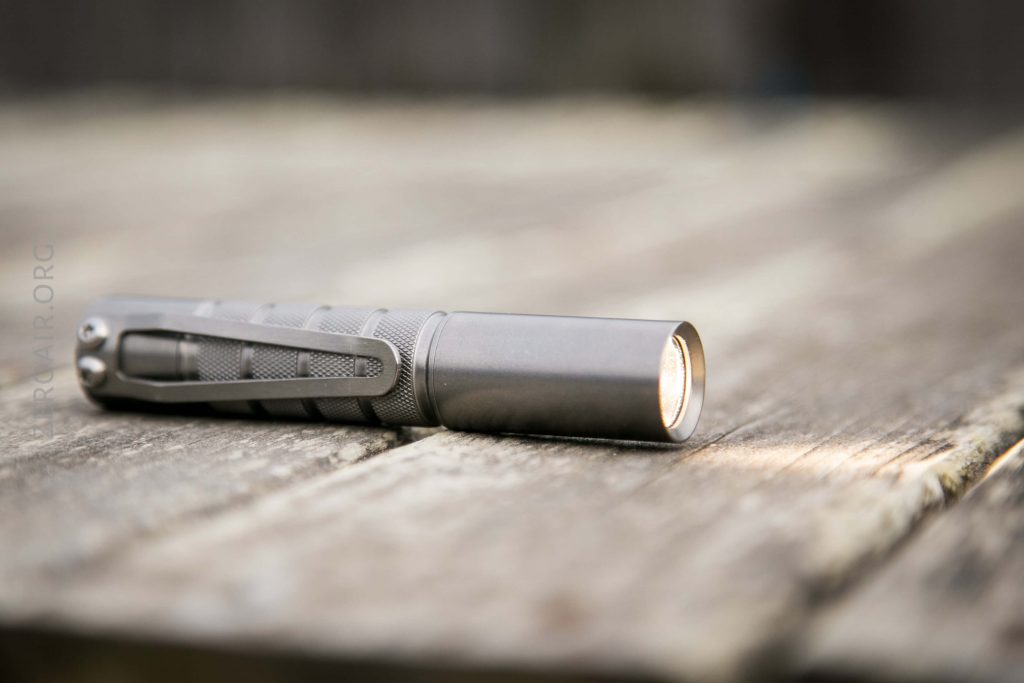
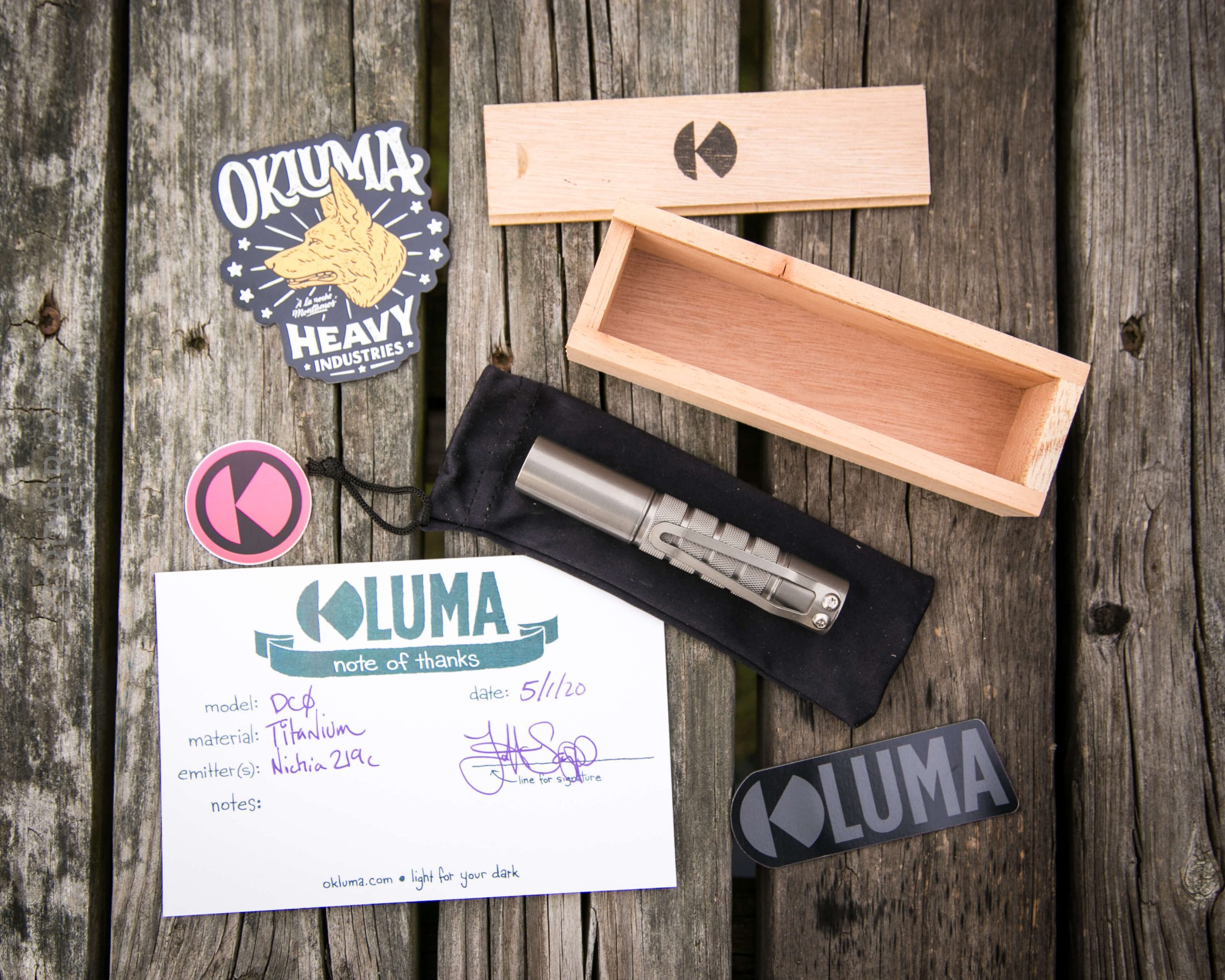


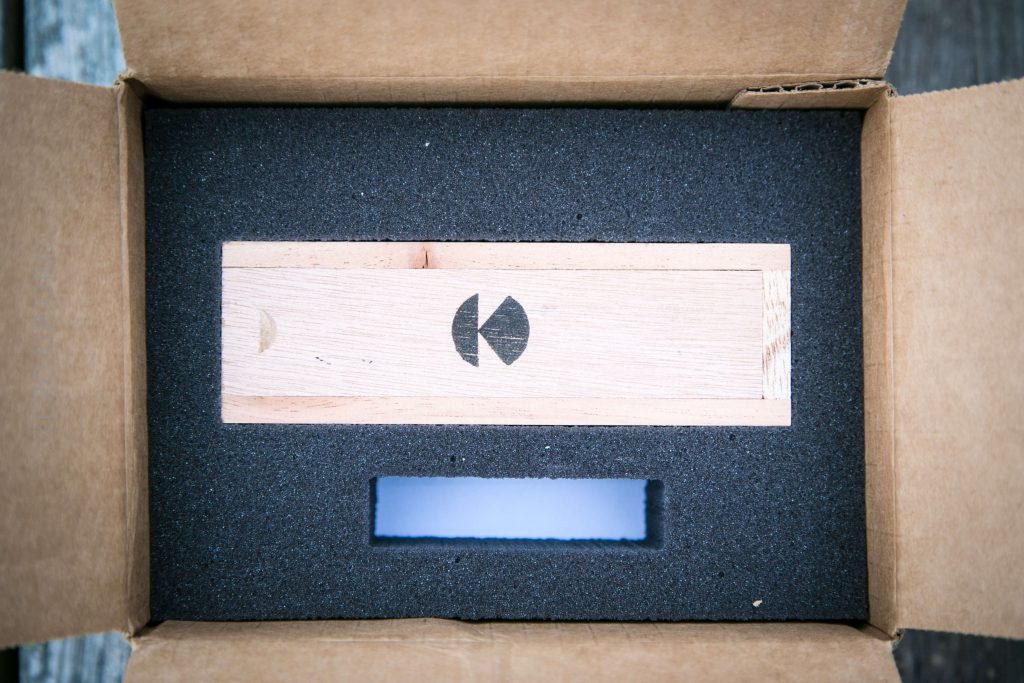

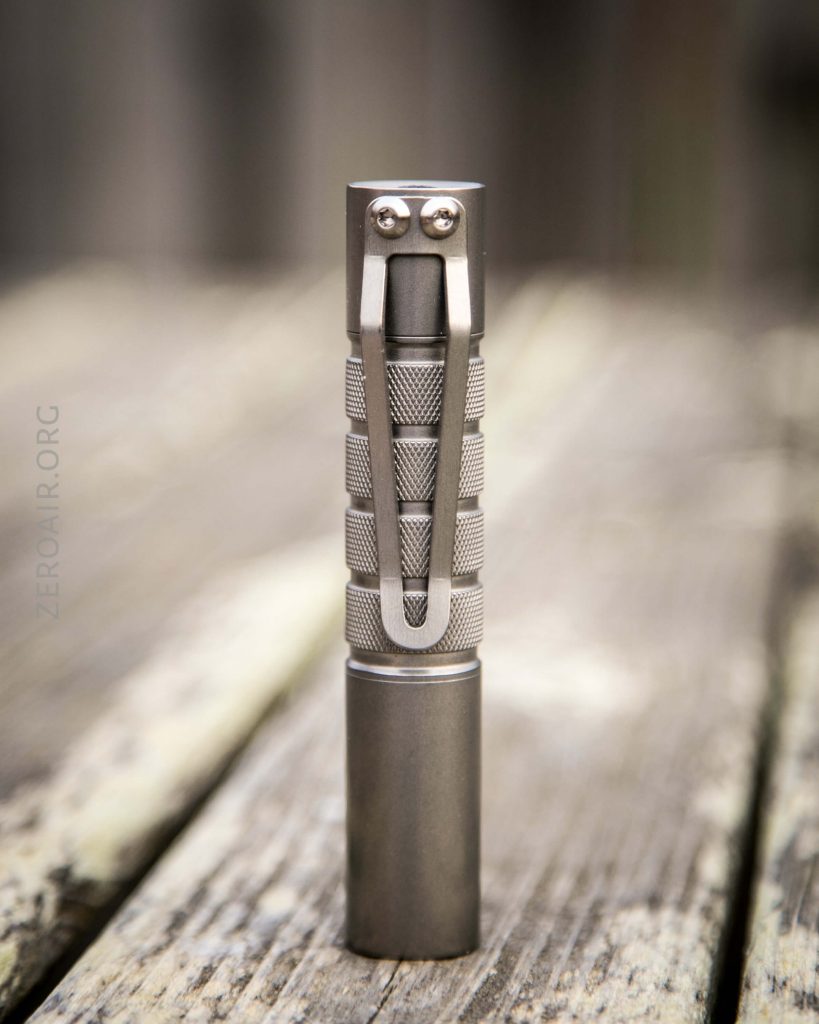
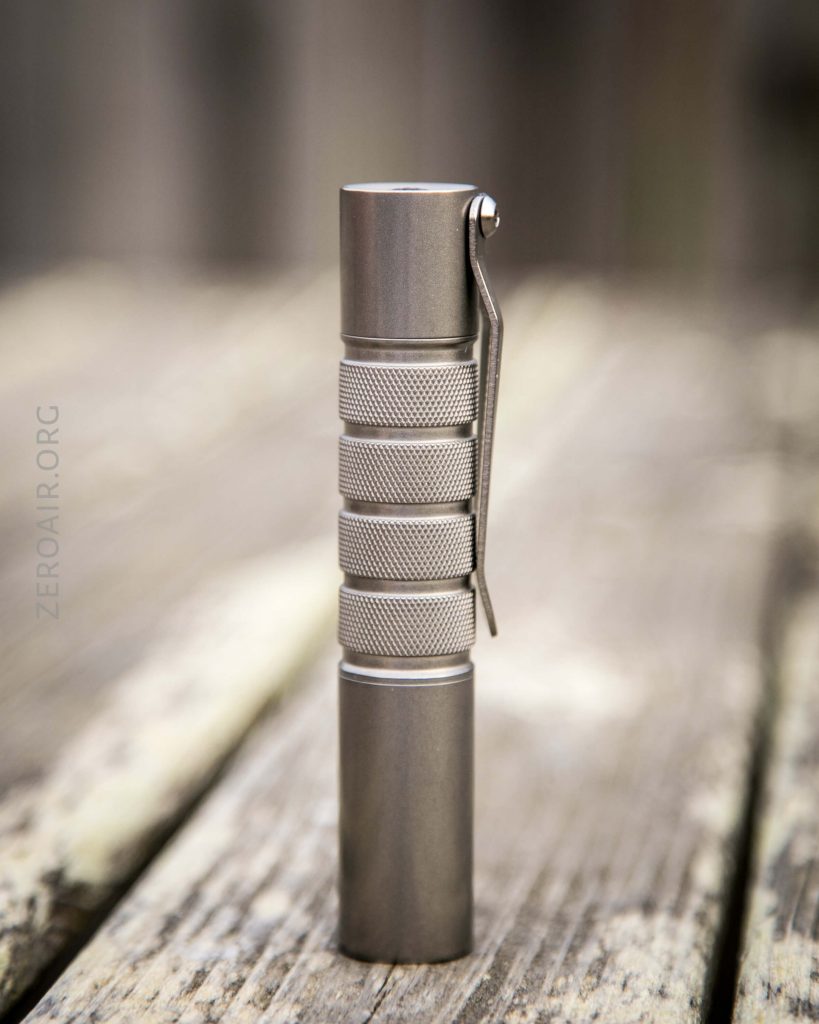



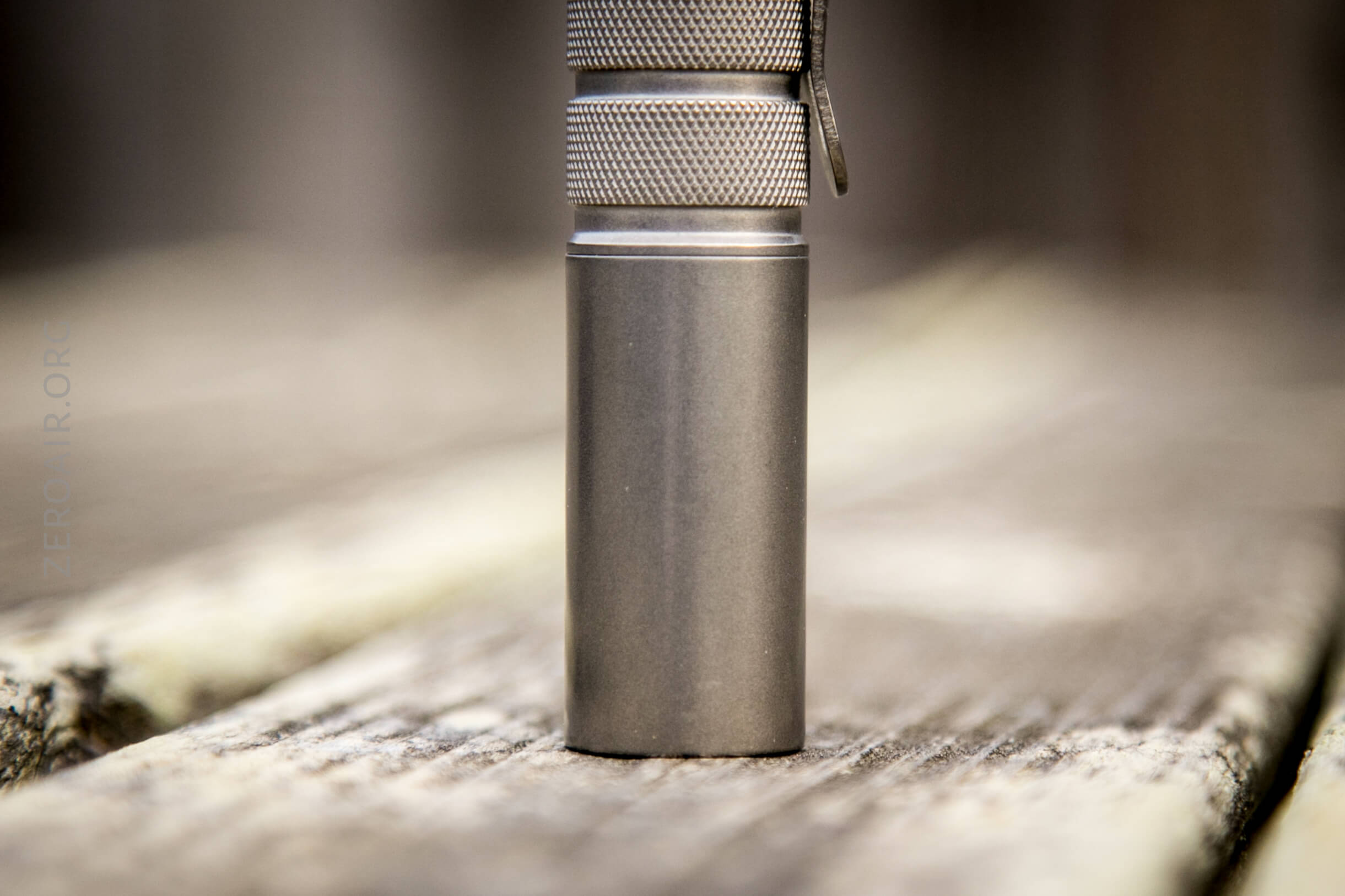
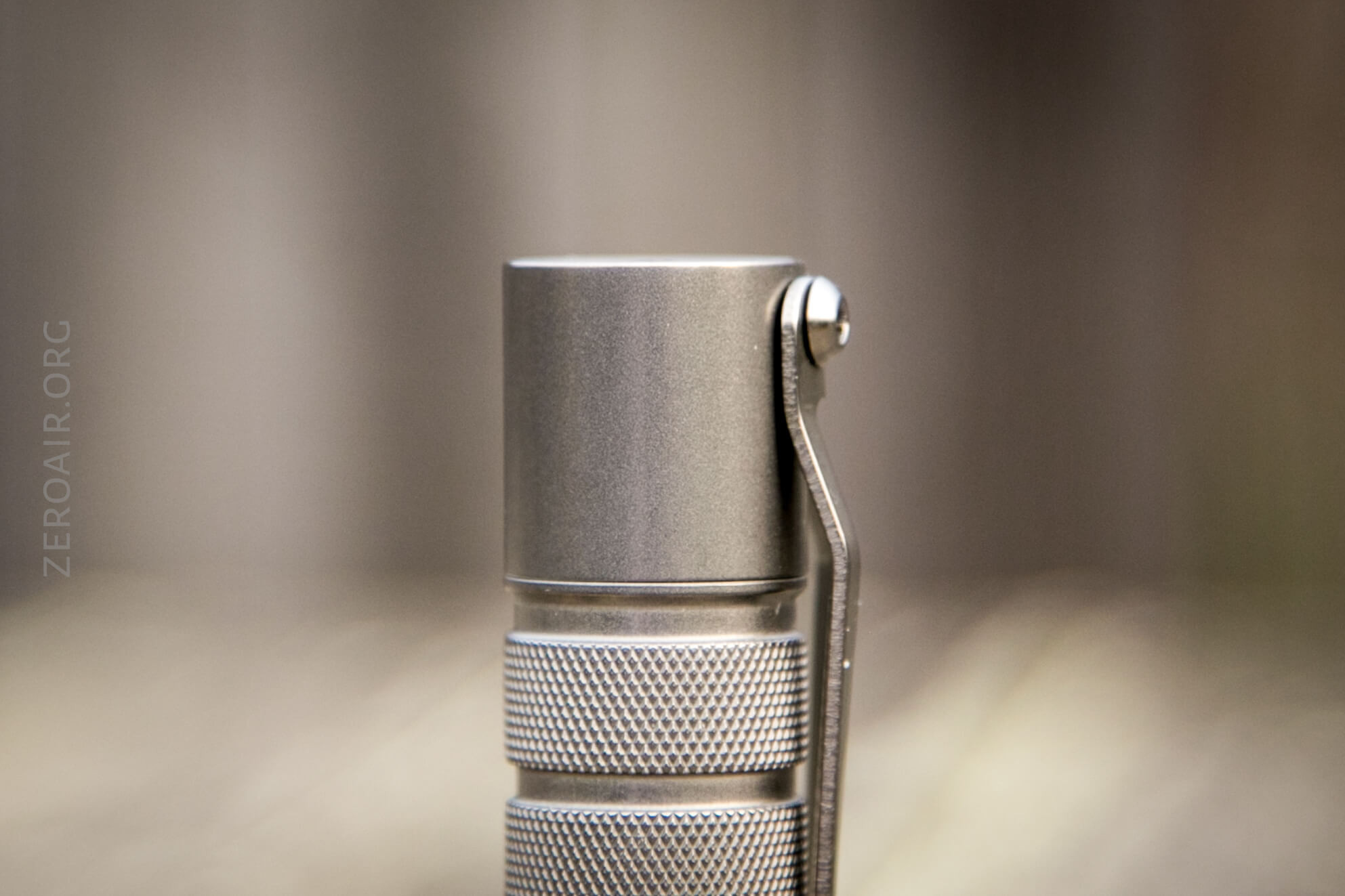
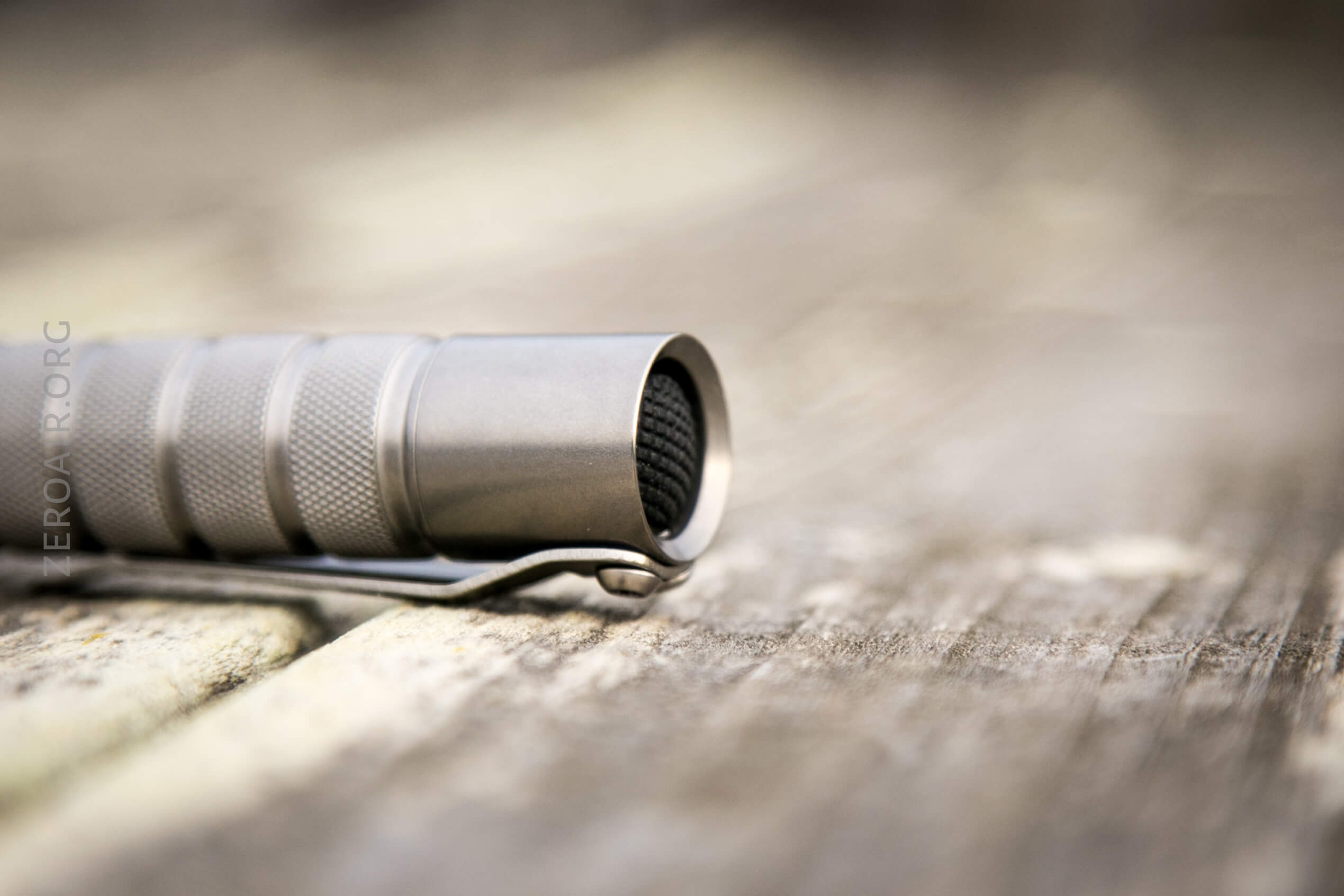
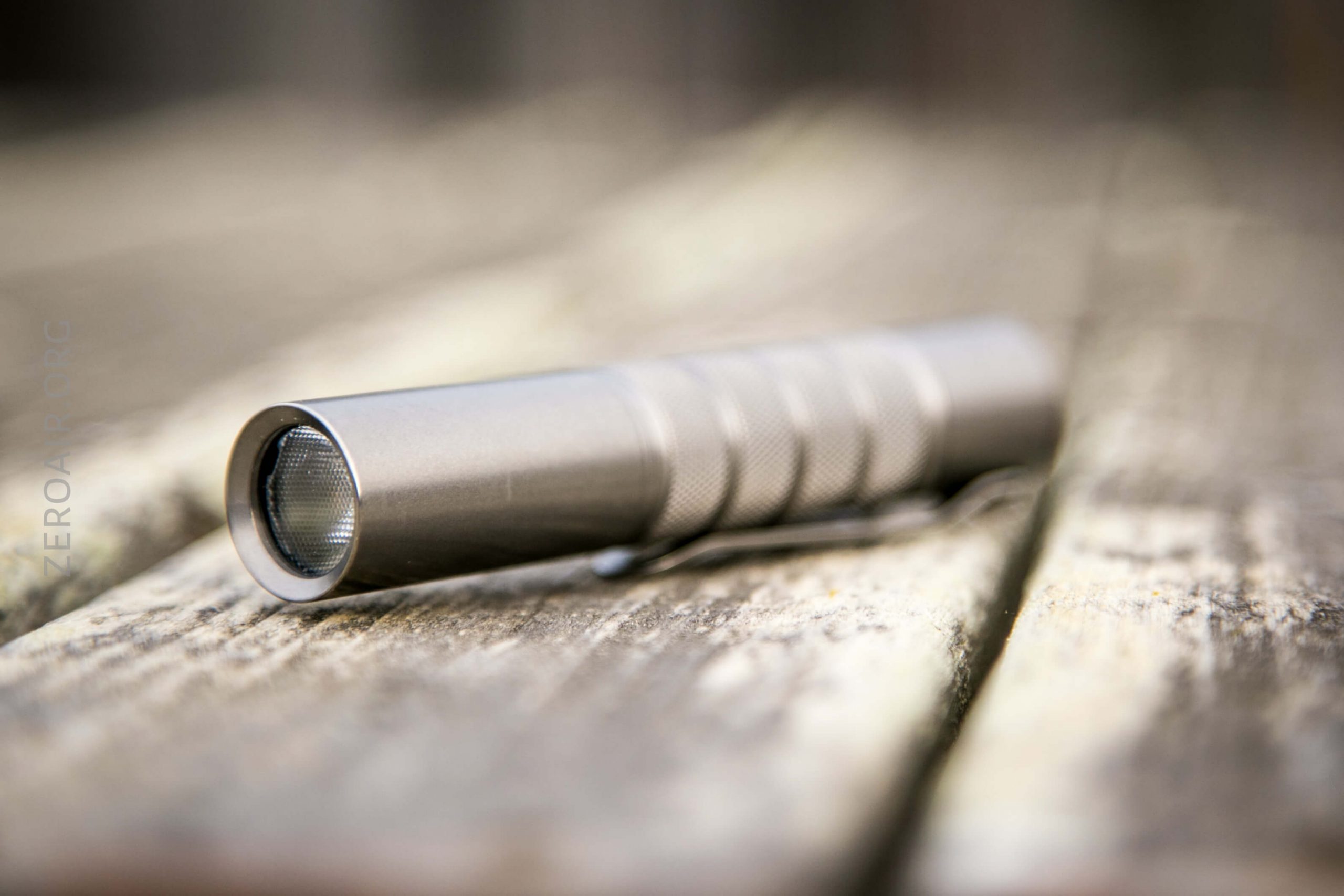
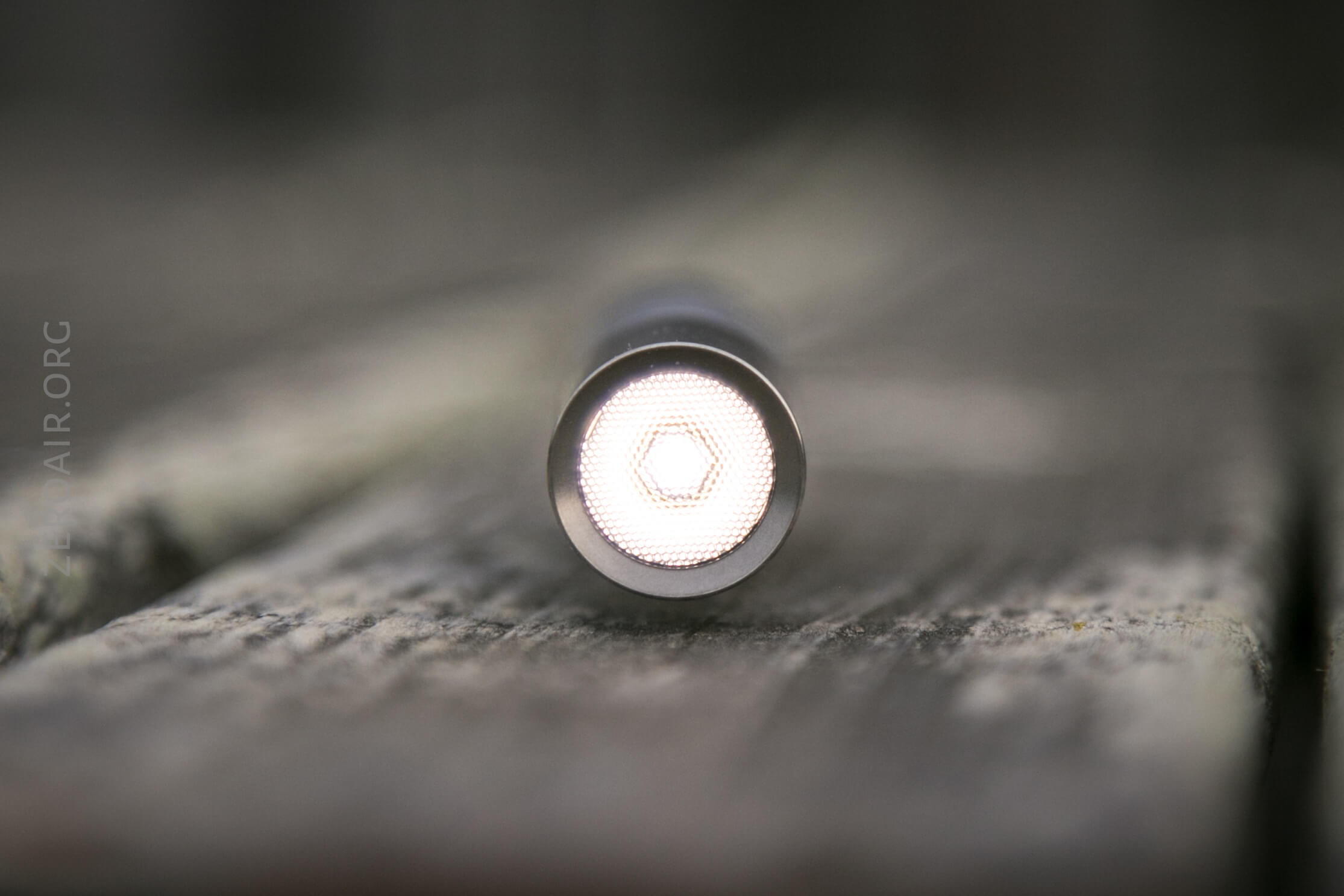
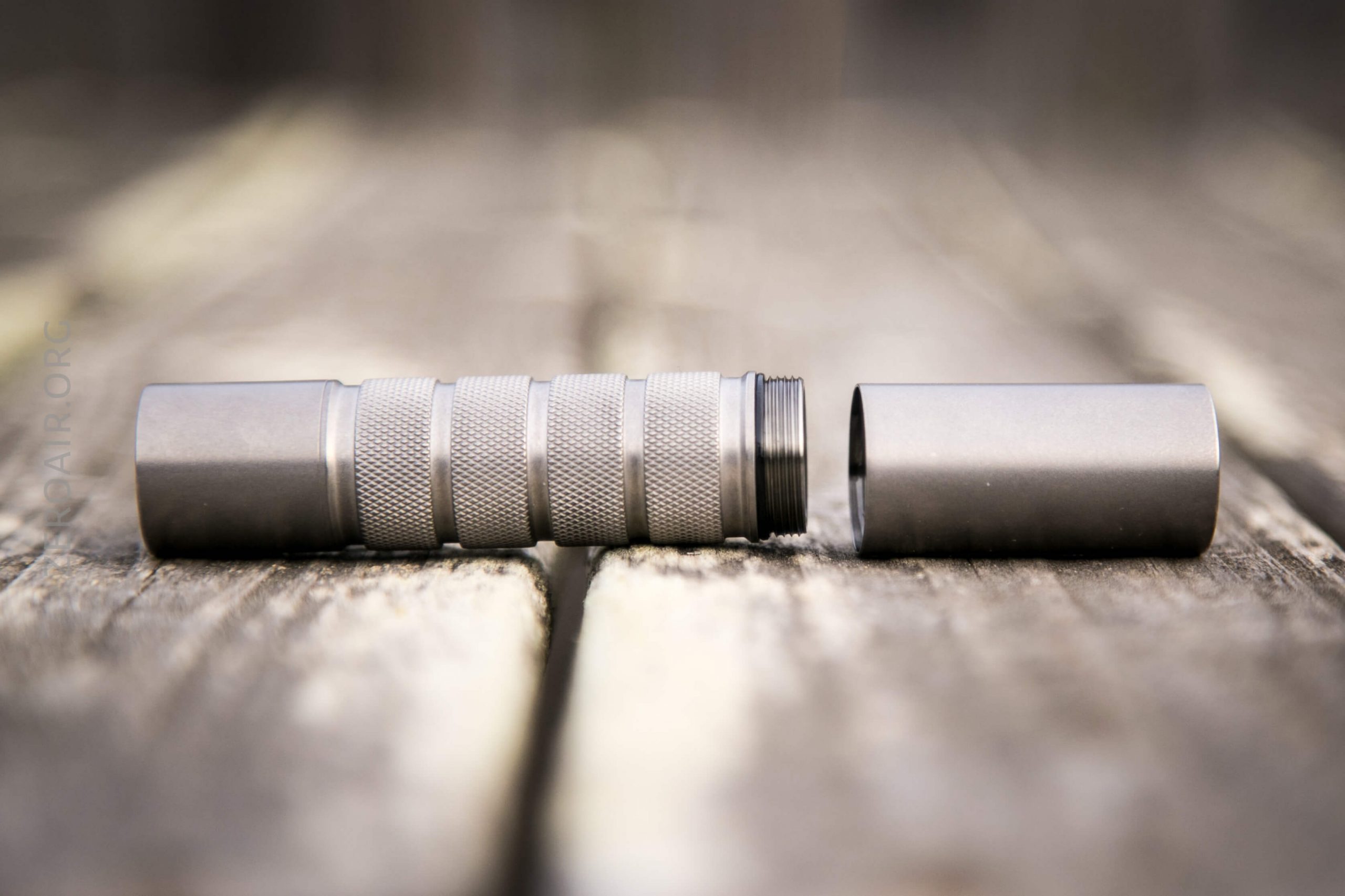
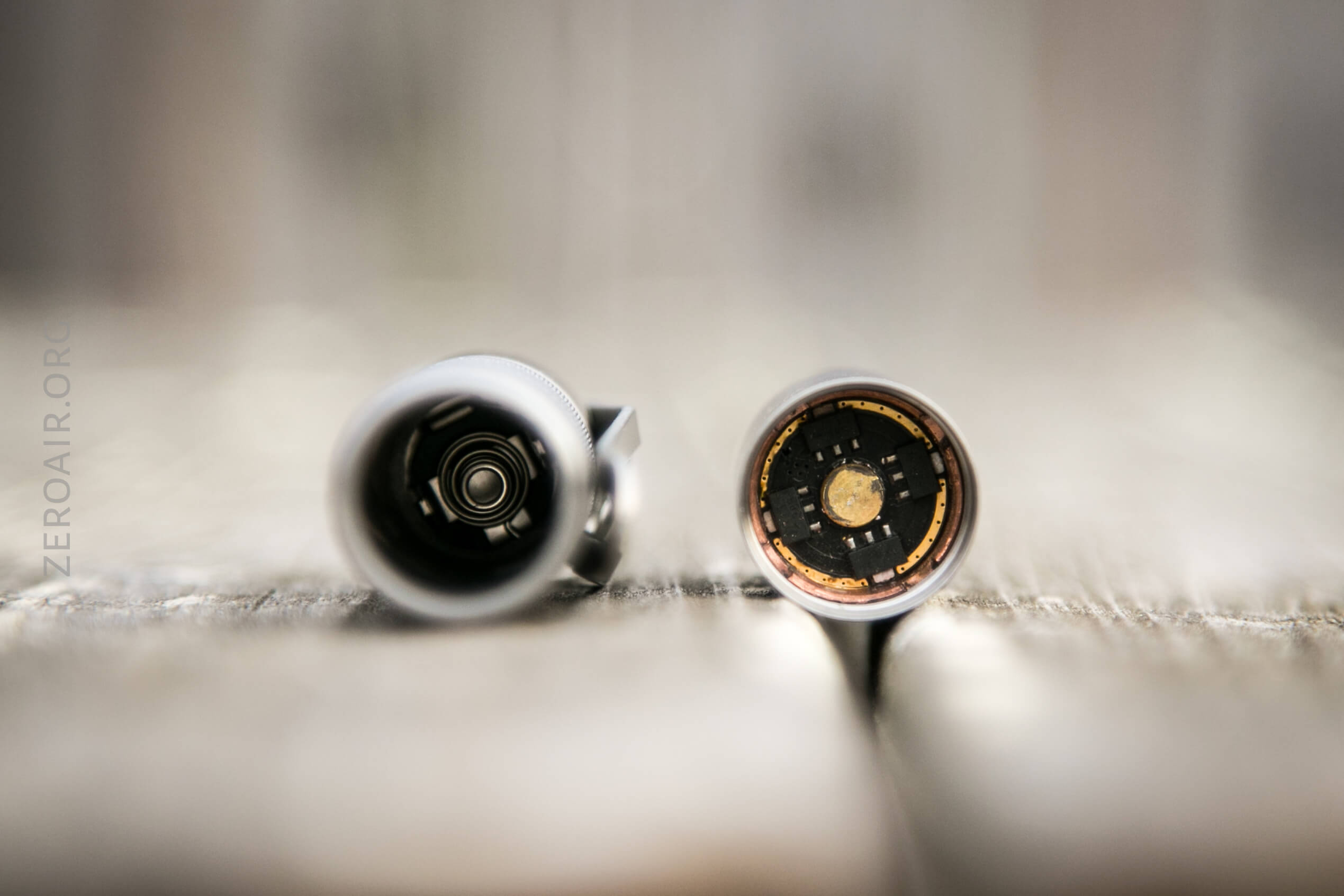
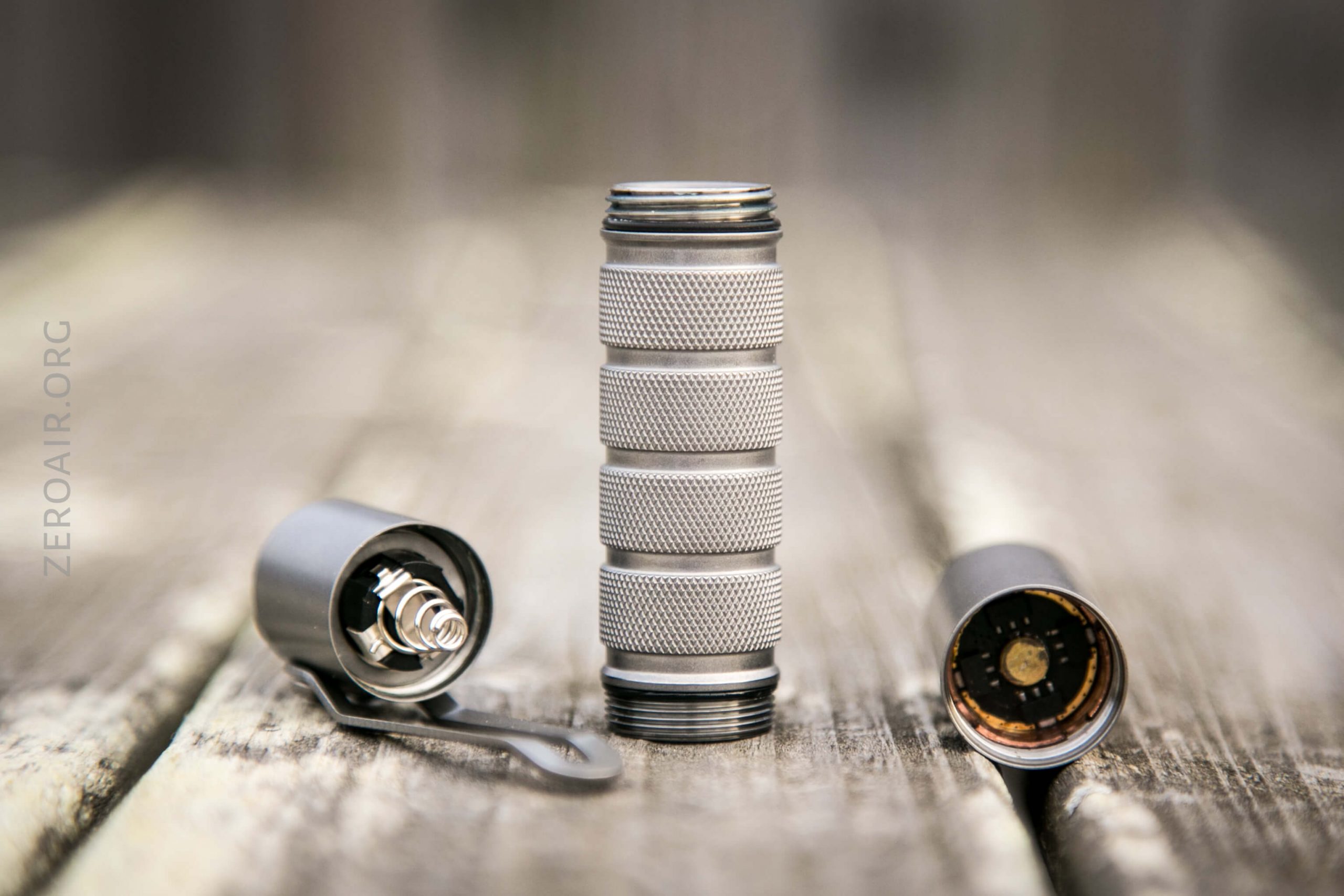
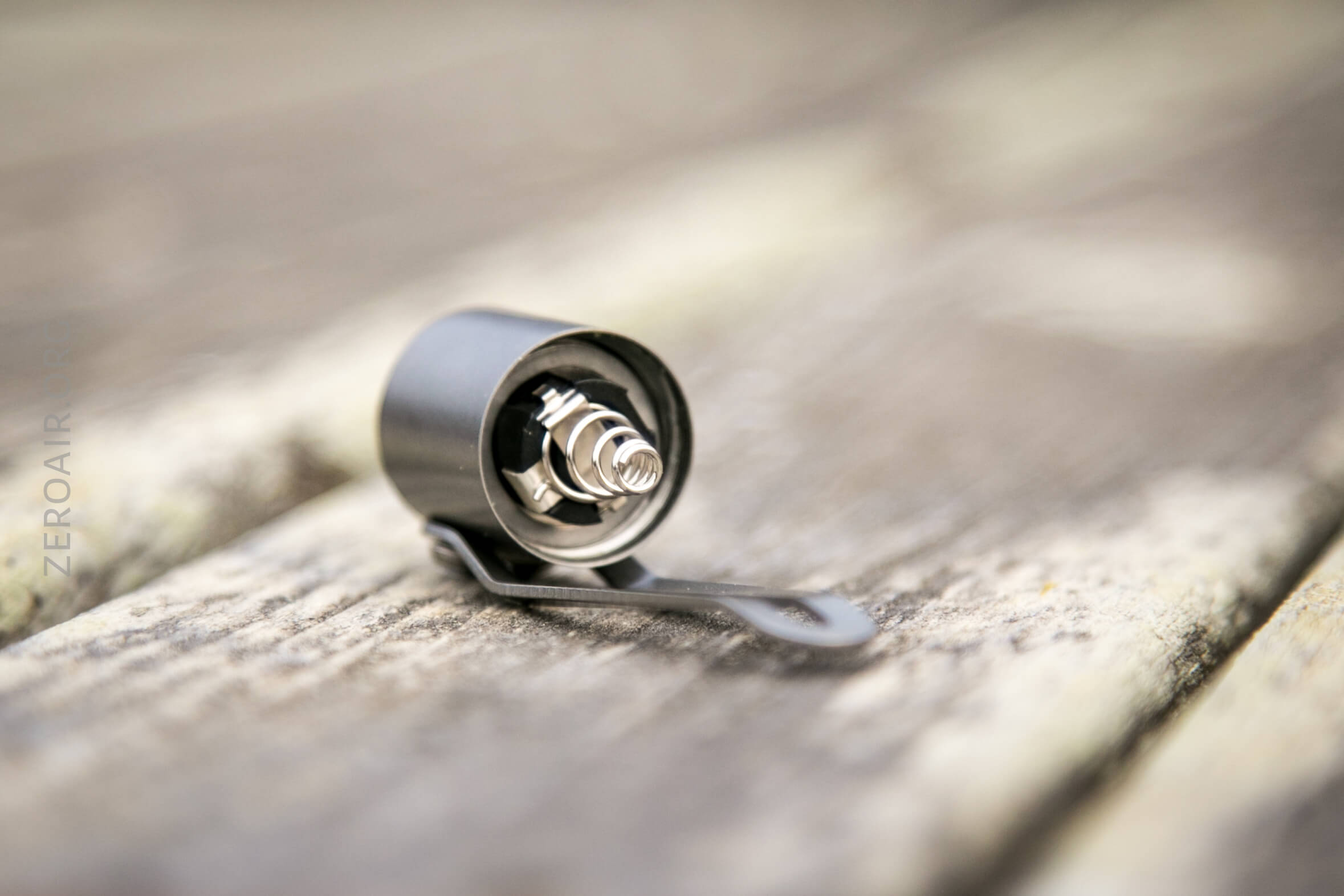

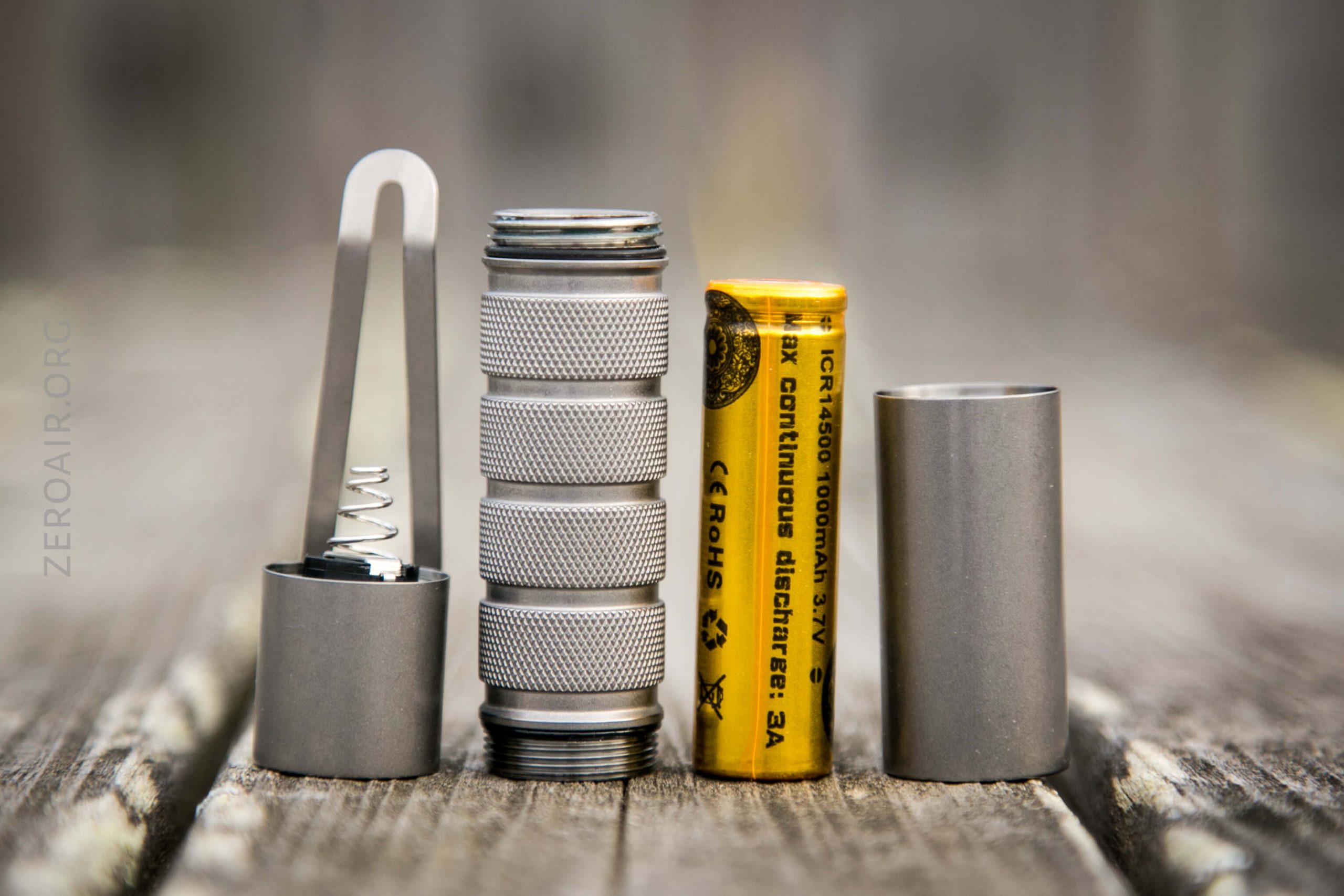
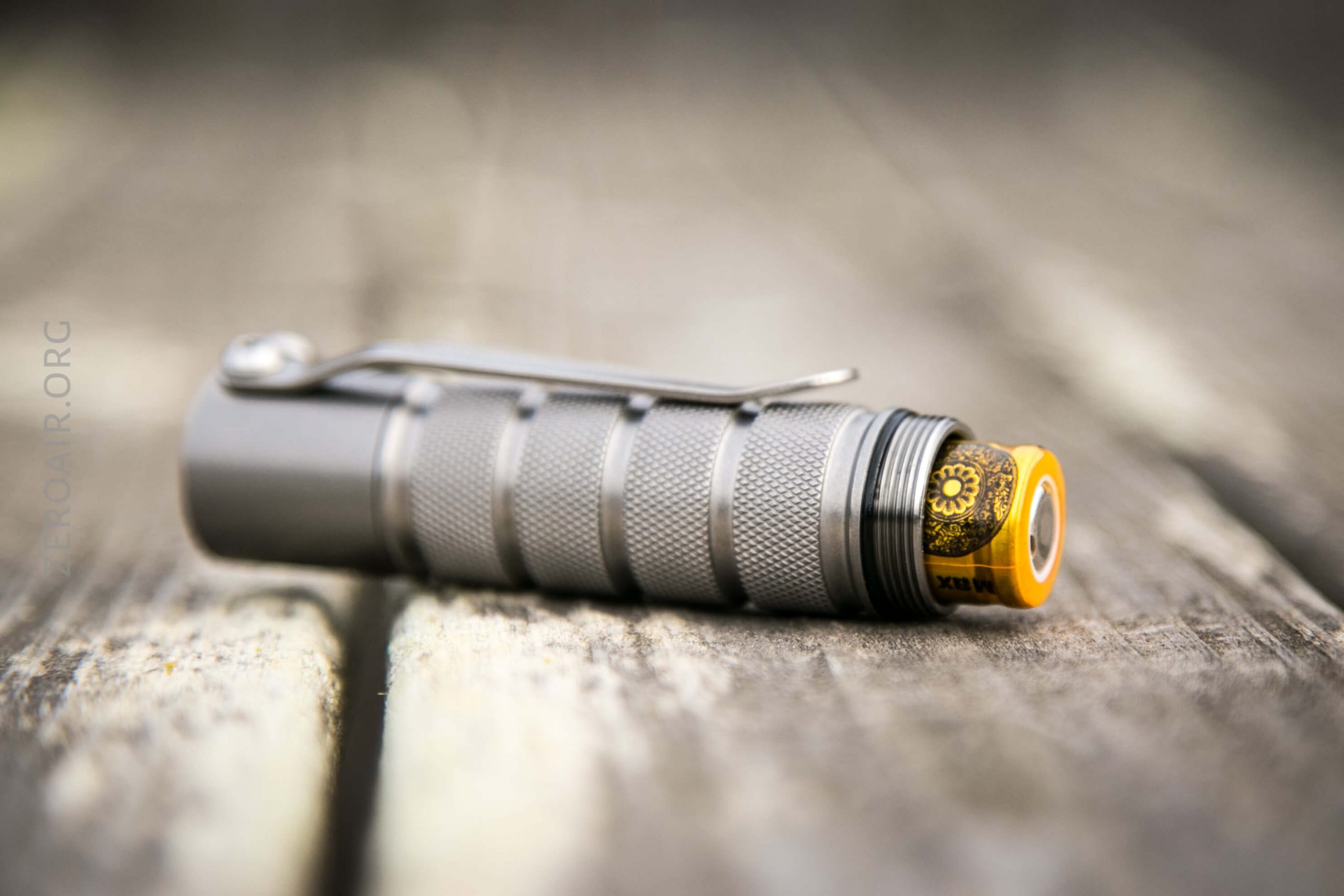
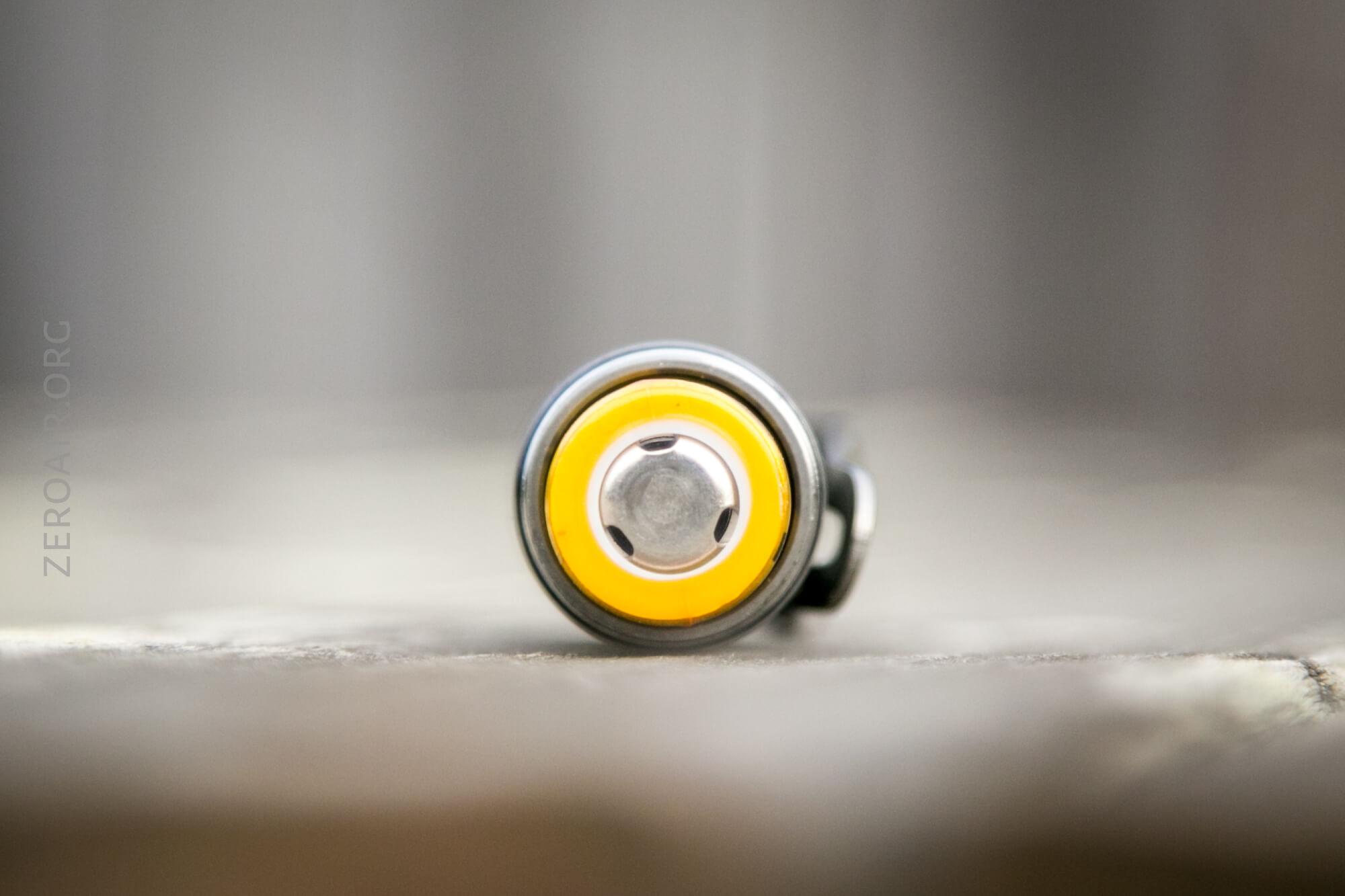

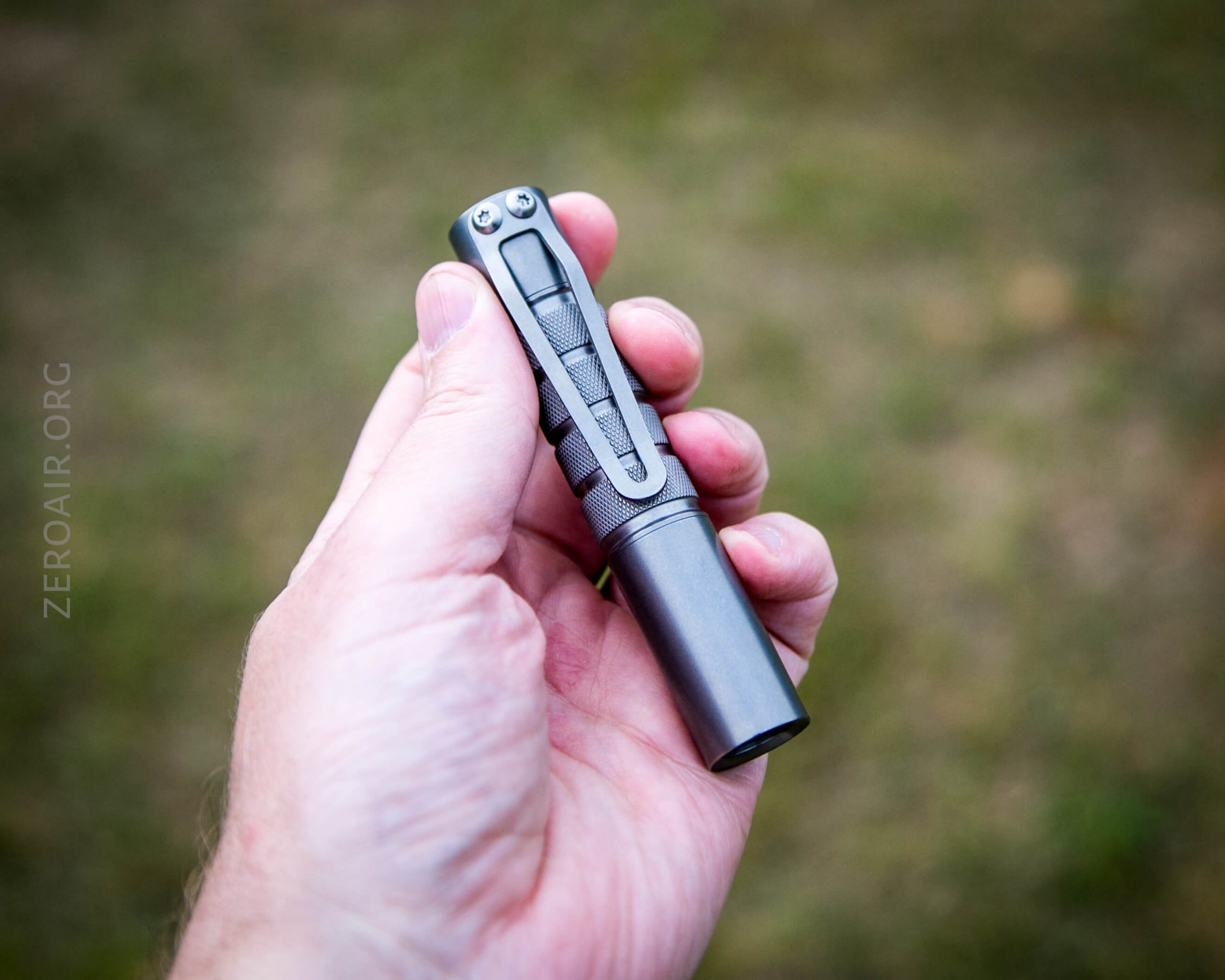











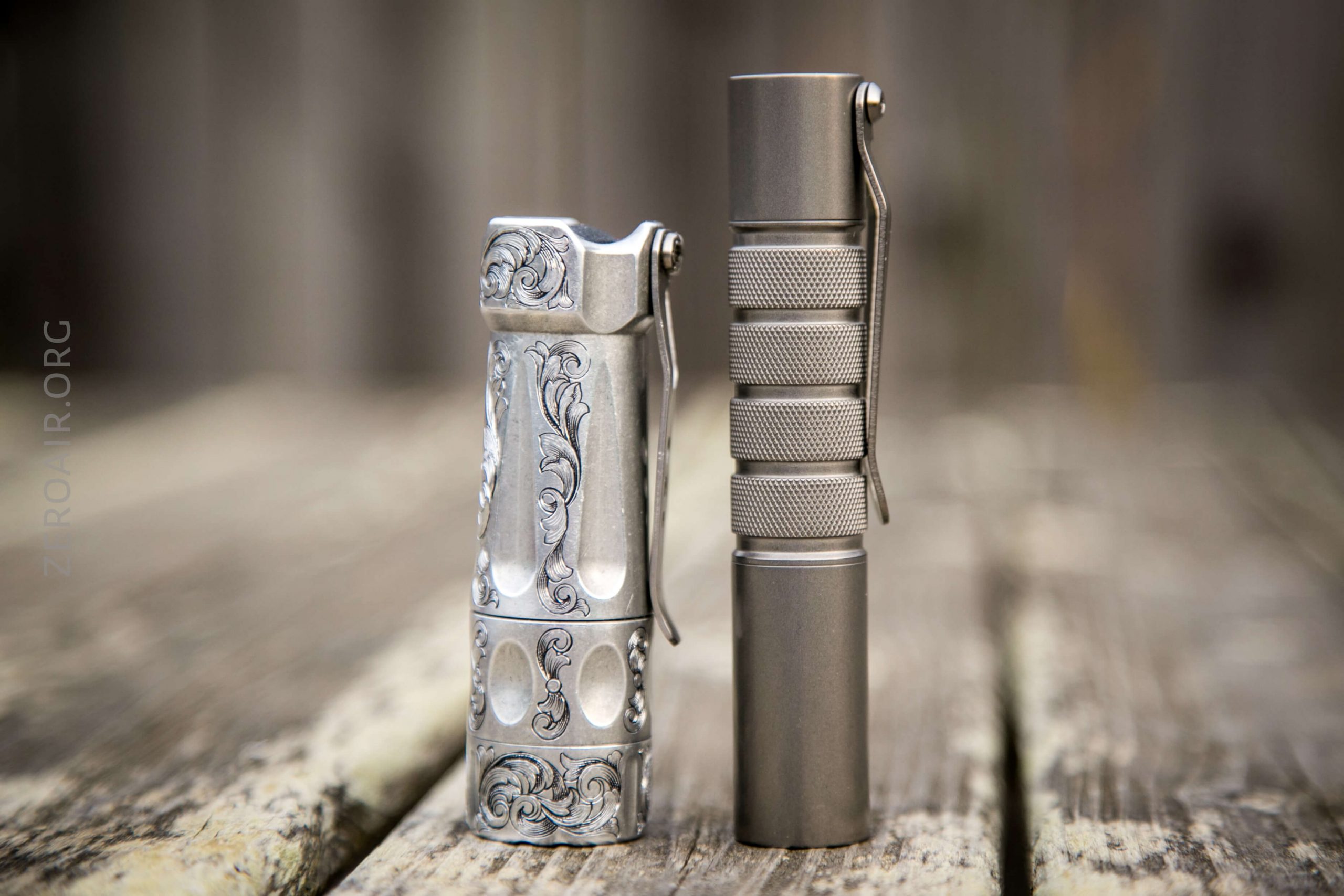
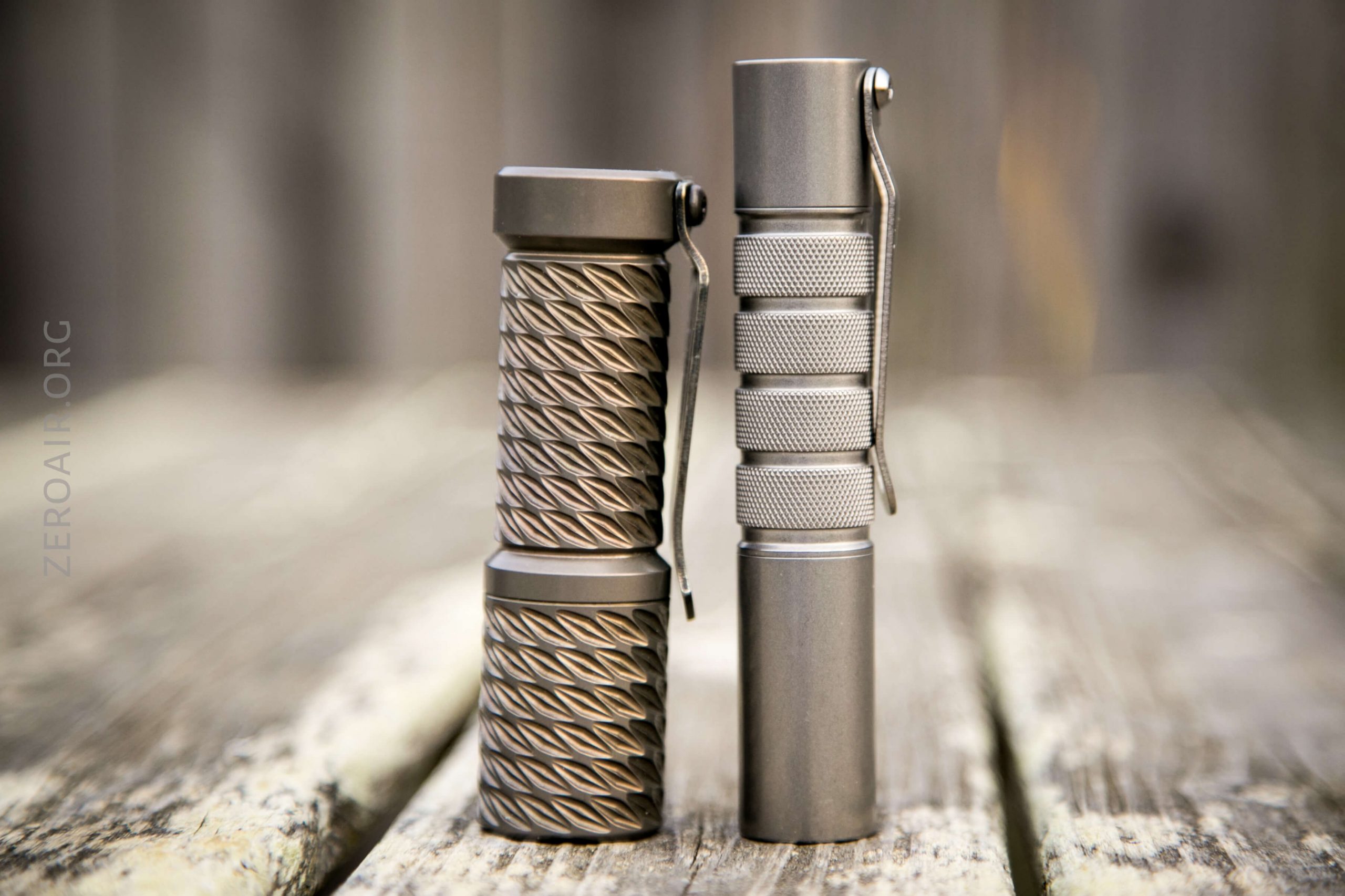



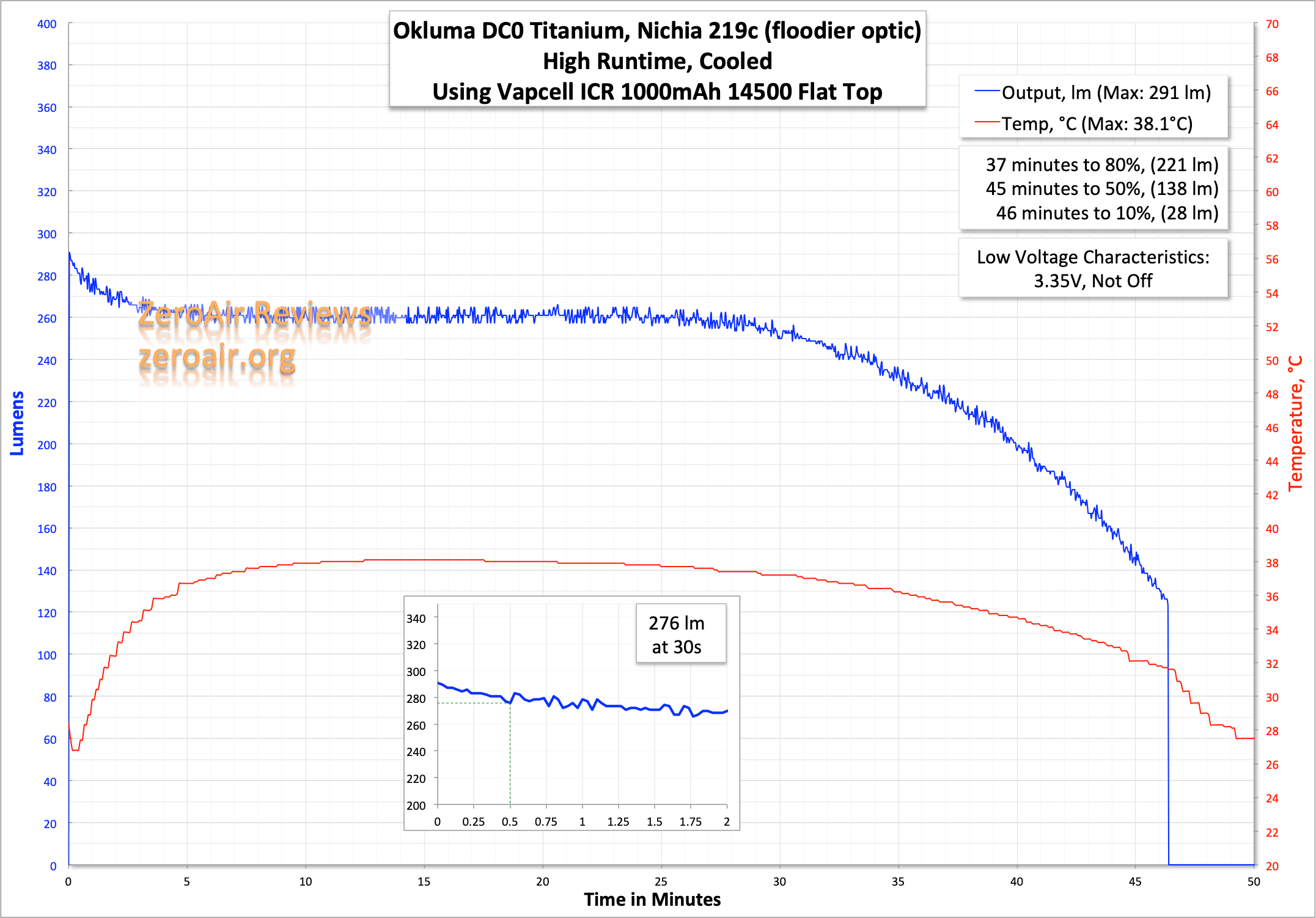
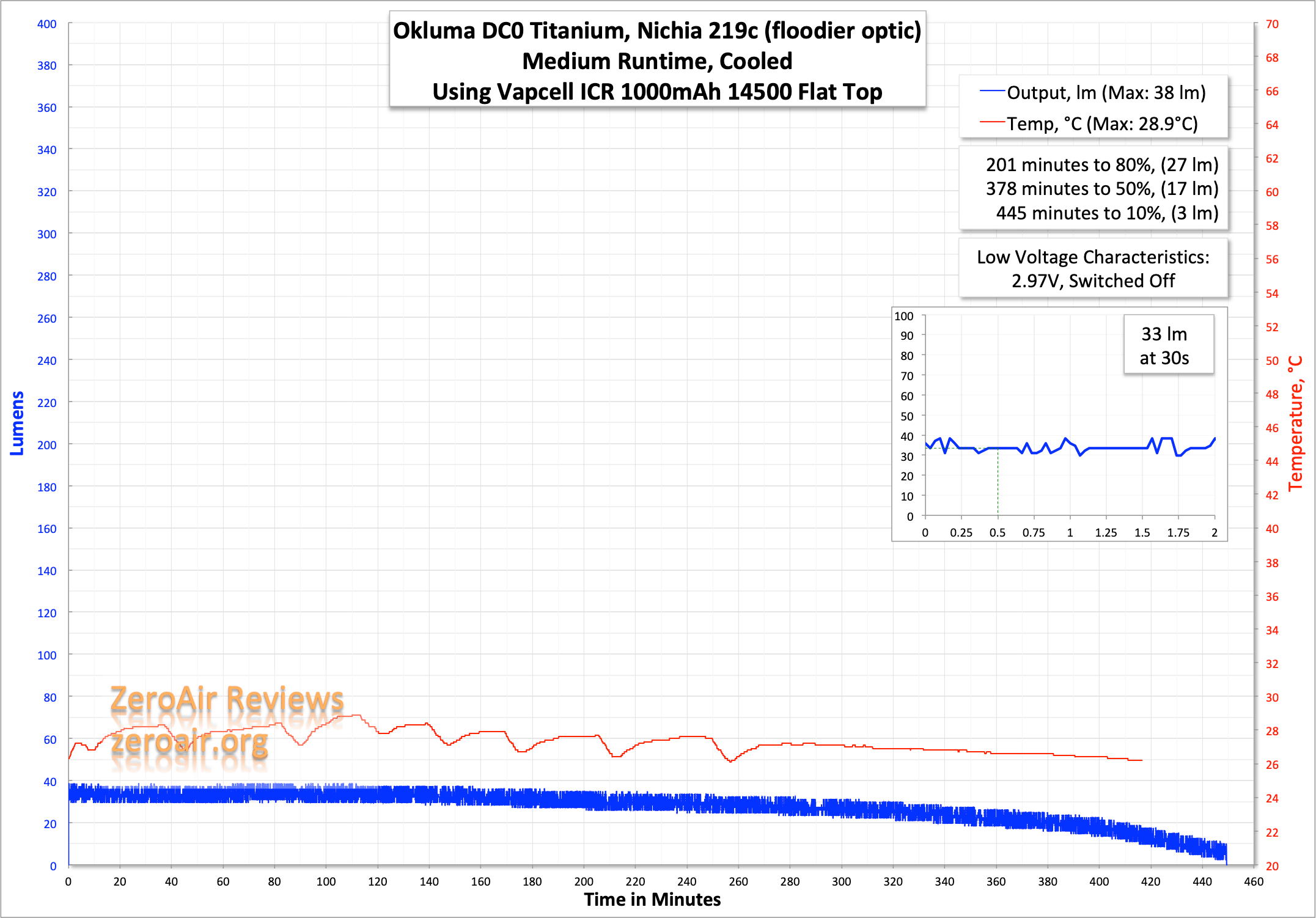



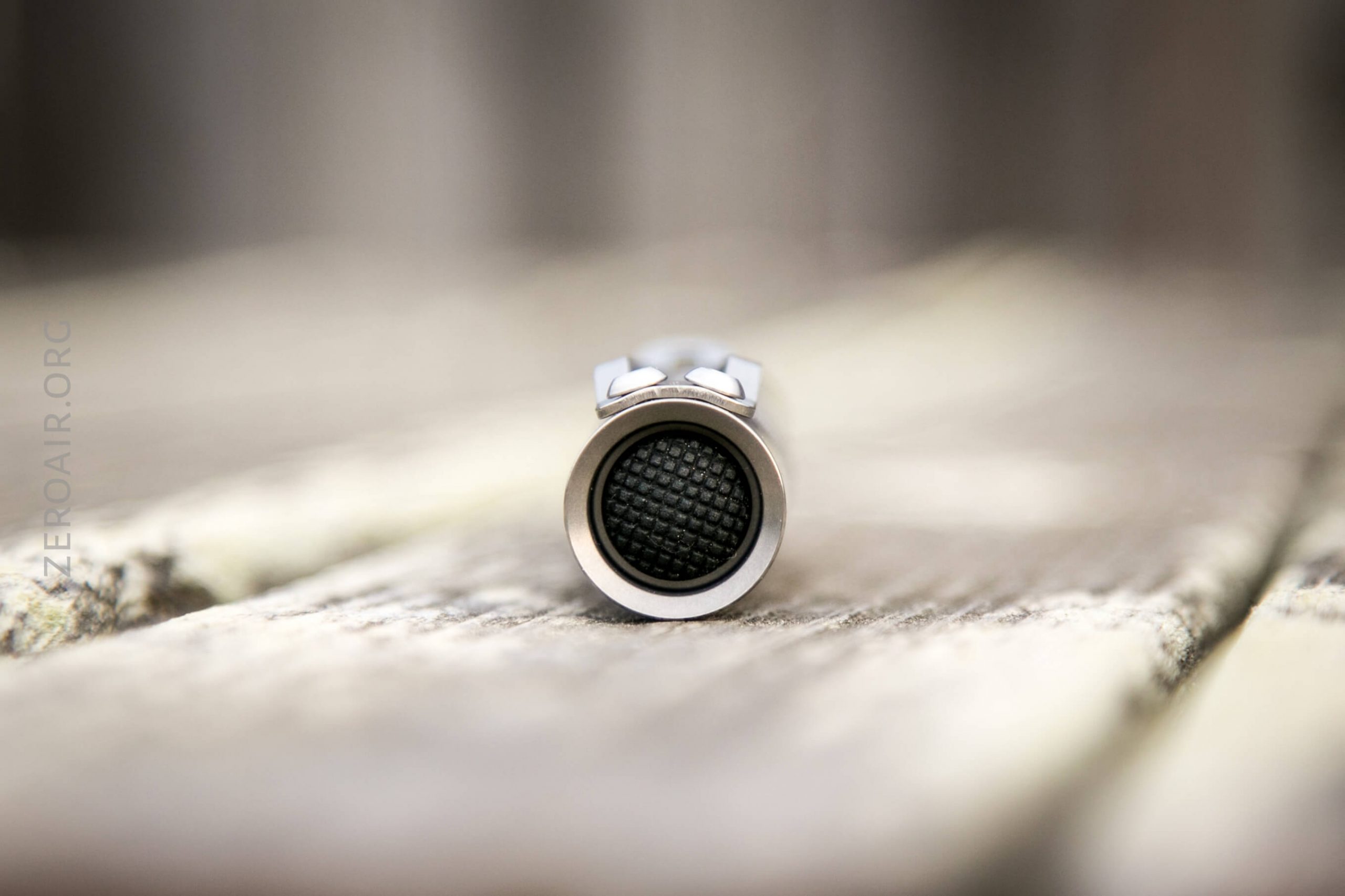
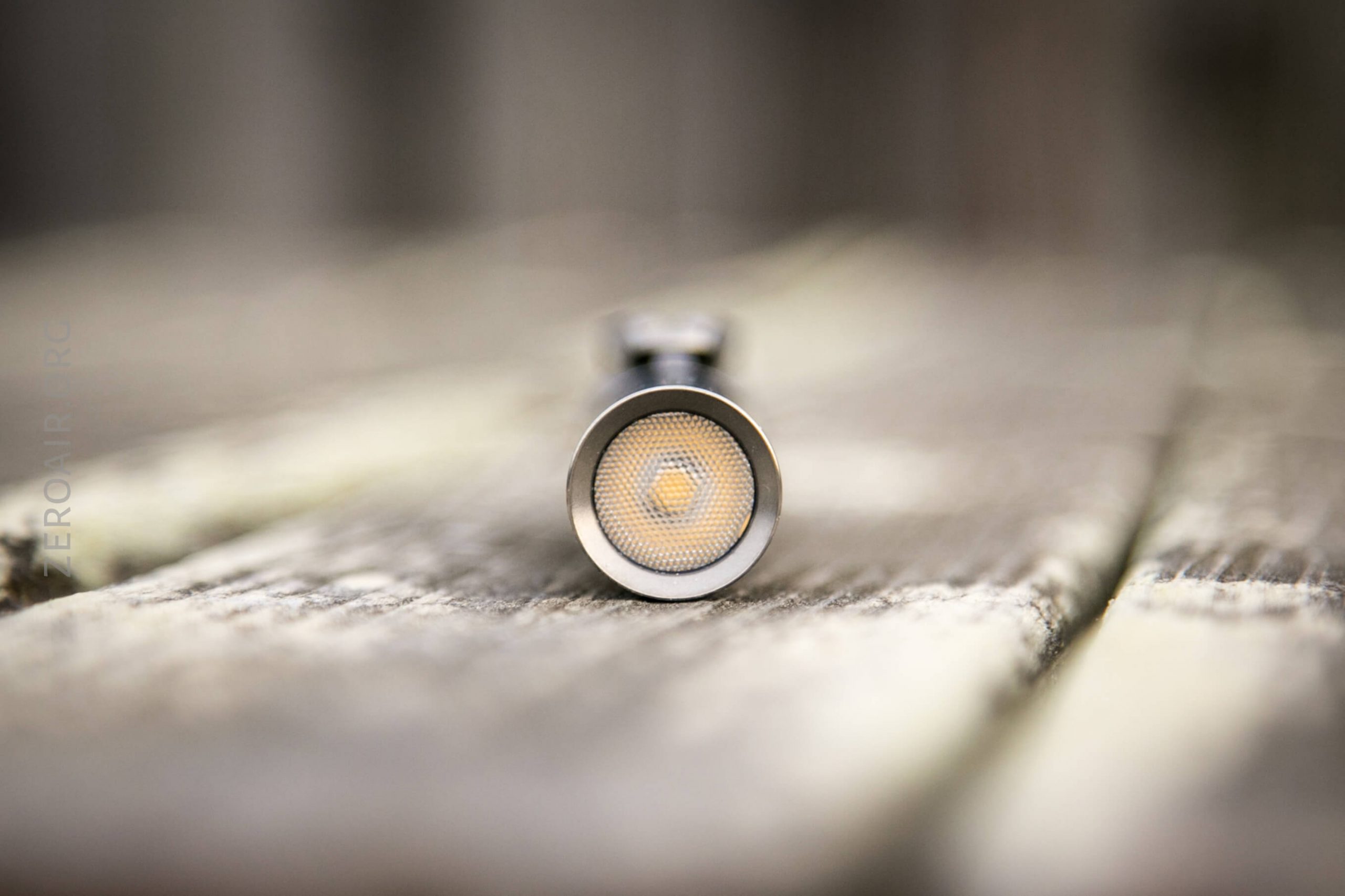
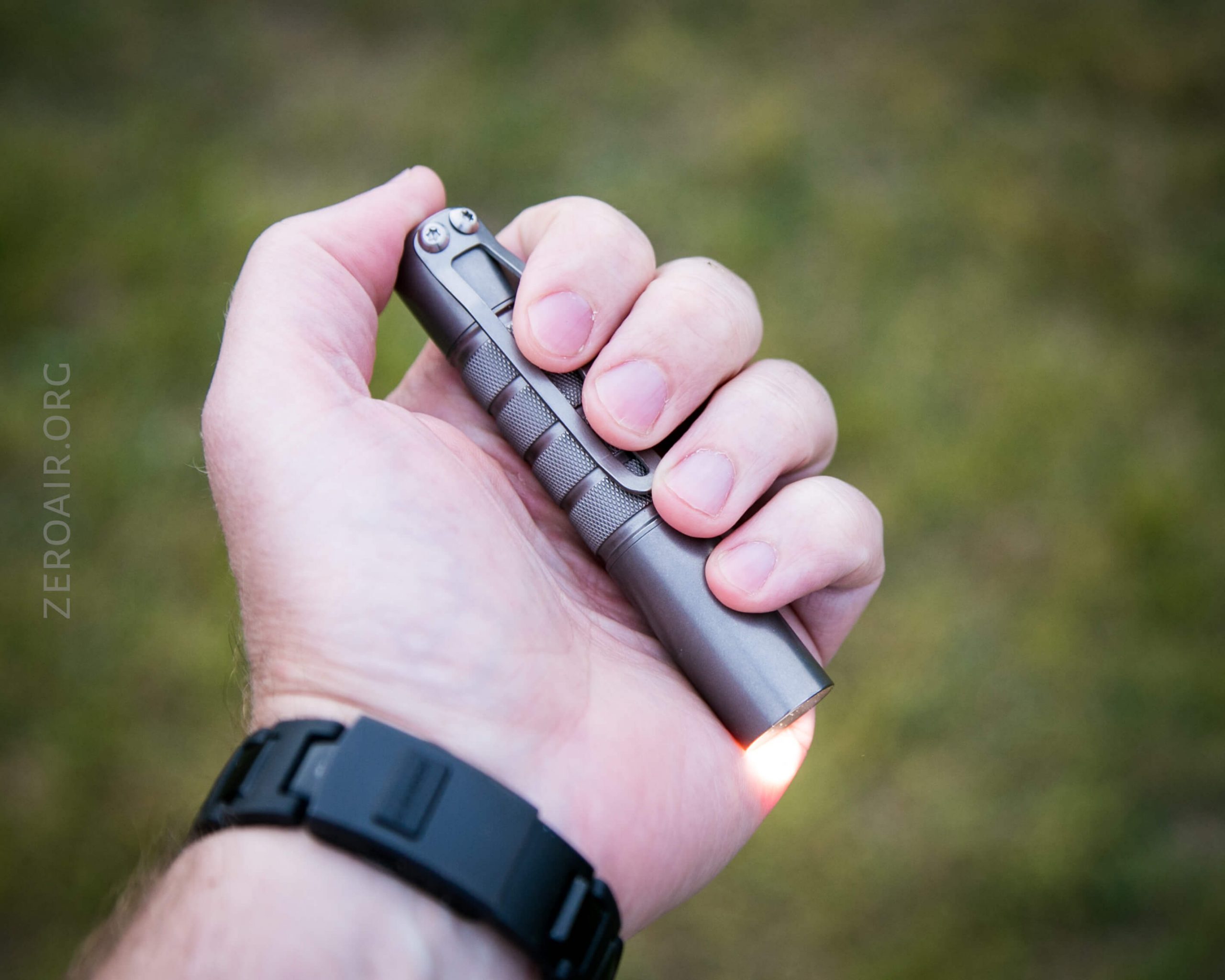



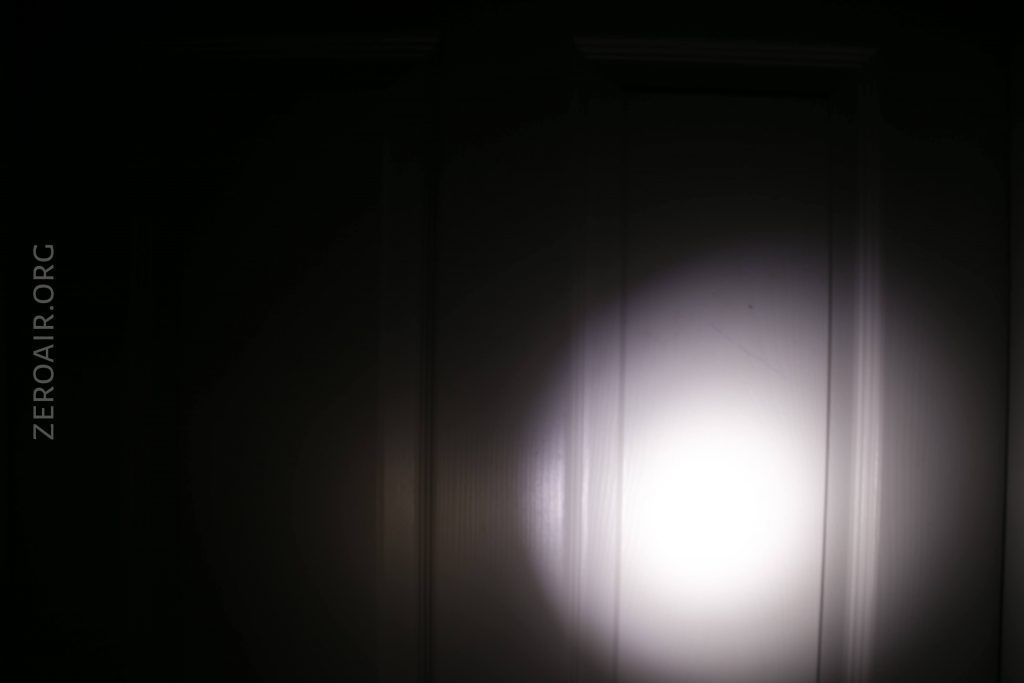



Got one of these myself in the first run, i would prefer a less floody optic as well.
This light sits in my manbag permanently and being Ti means mouth holding doesnt mark it.
Curious about the lumen claim since you got nowhere near it.
I recall reading the lights voltage feed has been reduced to reduce heating up too quick and extending LED life
Great review. Spot on. I just got the DC0 myself and I would love it to be a little bit shorter and have a little bit more power on high mode. The perfect EDC light for me would be an Eagletac D25A type light in size and operation while having an Okluma DC0 finish and design.
Thanks for reading!
Did you mention how many lumens were measured in the lowest setting and I missed it?
I’m hoping it has a sub-lumen moonlight mode, but couldn’t quite tell from the Modes and Currents table.
Does “ – “ mean it was too low to measure, i.e., <1 lm?
That setting was too low to be picked up by my calibrated tester. I have since improved though and can report those low values more accurately, but that doesn’t help for the DC0. Sorry!
No worries, and thank you!
Pingback: Holiday Flashlight Guide 2020 - You Should Buy These! - ZeroAir Reviews